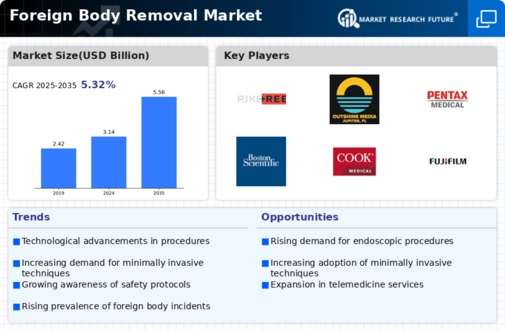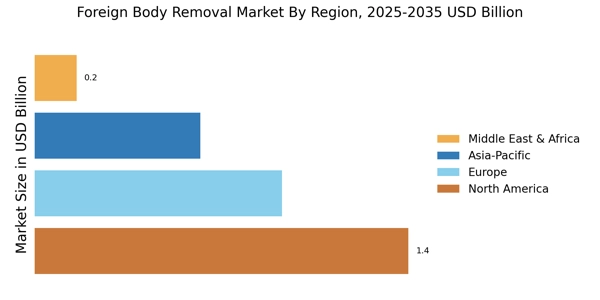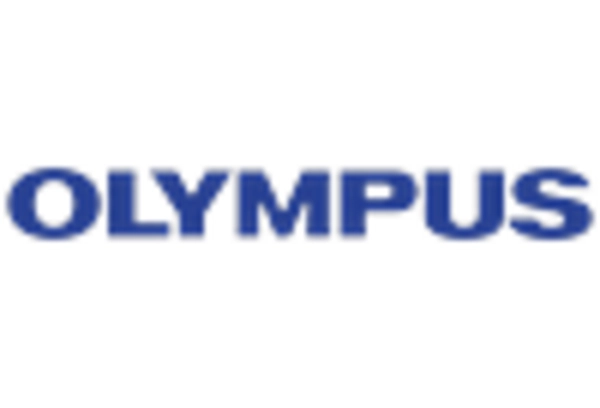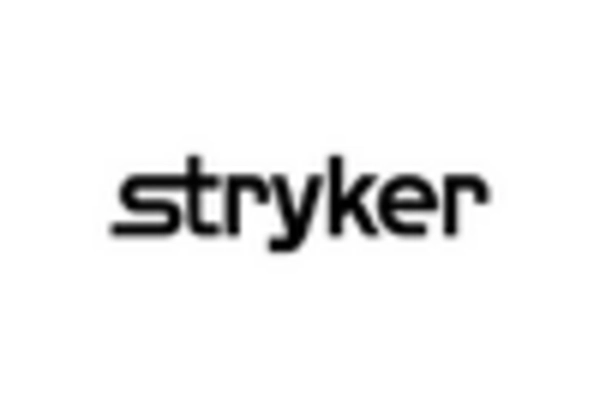Growing Geriatric Population
The aging population is a critical factor influencing the Foreign Body Removal Market. As individuals age, they may experience a decline in cognitive and motor skills, increasing the likelihood of accidental ingestion of foreign objects. Reports indicate that the geriatric demographic is more susceptible to such incidents, leading to a higher demand for foreign body removal services. Healthcare systems are adapting to this demographic shift by enhancing their capabilities in managing foreign body cases. This trend is likely to drive the market as healthcare providers seek to implement specialized training programs and invest in advanced removal technologies tailored for older patients. The implications for the Foreign Body Removal Market are profound, as the need for effective solutions becomes increasingly urgent.
Rising Healthcare Expenditure
An increase in healthcare expenditure across various regions is contributing to the expansion of the Foreign Body Removal Market. As governments and private sectors allocate more funds towards healthcare, there is a corresponding rise in investments in medical technologies and services. This trend is particularly evident in developing regions, where improving healthcare infrastructure is a priority. Enhanced funding allows for the procurement of advanced foreign body removal devices and the training of healthcare professionals. Market analysis indicates that regions with higher healthcare spending are likely to experience faster growth in the Foreign Body Removal Market, as access to better resources and technologies becomes more prevalent.
Increased Regulatory Standards
The Foreign Body Removal Market is also being shaped by heightened regulatory standards aimed at ensuring patient safety. Regulatory bodies are implementing stricter guidelines for medical devices used in foreign body removal procedures. Compliance with these regulations is essential for manufacturers, prompting them to innovate and improve their product offerings. This trend is likely to foster a competitive environment where companies strive to meet or exceed regulatory expectations. As a result, the market may witness an influx of new, safer, and more effective removal devices. The emphasis on quality and safety is expected to enhance consumer confidence, thereby driving growth in the Foreign Body Removal Market.
Rising Incidence of Foreign Body Ingestion
The increasing prevalence of foreign body ingestion, particularly among children and the elderly, appears to be a significant driver for the Foreign Body Removal Market. Statistics indicate that thousands of cases are reported annually, necessitating urgent medical intervention. This trend is likely to escalate due to lifestyle changes and increased consumption of small, non-food items. As a result, healthcare facilities are investing in advanced removal technologies to address this growing concern. The demand for specialized medical devices and trained personnel is expected to rise, thereby propelling the market forward. Furthermore, the economic burden associated with treating complications from foreign body ingestion may lead to increased funding for research and development in this sector, ultimately enhancing the Foreign Body Removal Market.
Technological Innovations in Medical Devices
Technological advancements in medical devices are transforming the Foreign Body Removal Market. Innovations such as endoscopic techniques and robotic-assisted surgeries are enhancing the efficiency and safety of foreign body removal procedures. The introduction of minimally invasive tools has led to shorter recovery times and reduced hospital stays, which are appealing to both patients and healthcare providers. Market data suggests that the segment of advanced removal devices is experiencing substantial growth, with projections indicating a compound annual growth rate of over 10% in the coming years. These innovations not only improve patient outcomes but also reduce healthcare costs, making them a focal point for investment in the Foreign Body Removal Market.

















